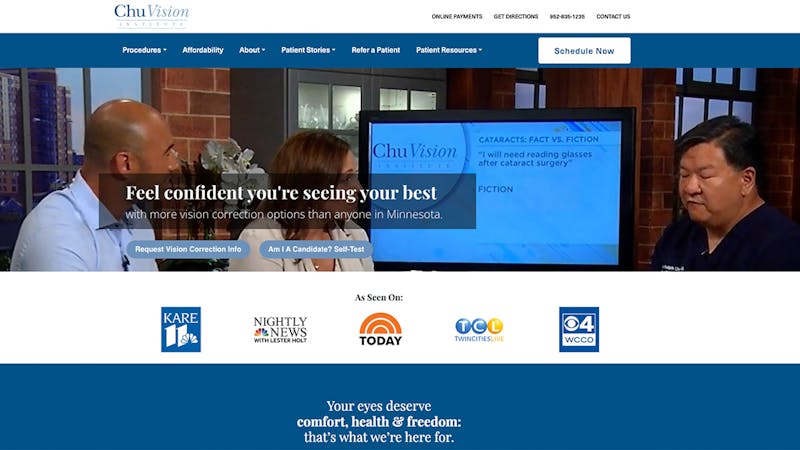
For individuals with cataracts or presbyopia who wish to reduce or eliminate their dependence on reading glasses, this is a golden age of treatment options — and the best may be yet to come.
Anyone who has had to continually put reading glasses on to perform tasks, such as reading a book or typing a text message on a cell phone and take them off knows what a tiresome practice it is. Chu Vision Institute — located at 9117 Lyndale Avenue South in Bloomington — offers a variety of options to help patients put down their reading glasses.
One of the most effective options is Crystalens from Bausch & Lomb, a procedure designed to do more than correct clouding of the eye’s lens; it gives the patient better overall range of vision. Most people with cataracts typically develop them in both eyes, and Crystalens surgery is generally recommended for both eyes with a gap of two weeks between procedures. The surgery takes 15 to 20 minutes, after which time patients notice fewer halos and less glare than with a multifocal lens. For patients who have presbyopia but no cataracts, Chu Vision Institute offers the opportunity to participate in a clinical trial testing the efficacy of a corneal inlay that could prove to be the most exciting development yet in the quest to retire reading glasses forever.
Improving Focus
“Presbyopia — the loss of reading vision as the eye’s ability to focus diminishes with age — affects most people in their 40s to some extent,” says Y. Ralph Chu, M.D., founder and Medical Director of Chu Vision Institute. “The condition hinders some of the simplest everyday functions, such as reading a computer screen or the speedometer on a car. The PresbyLens by ReVision Optics, Inc. has the potential to improve these functional deficits and reduce, if not eliminate, the inconvenience of reading glasses.”
The PresbyLens microlens is composed of a hydrogel and mimics the optical characteristics of the cornea, which the lens supplies with nutrients and fluids. The lens is less than half as thick as a human hair and has a diameter of 2 millimeters.
To implant the PresbyLens, an ophthalmologist creates a LASIK flap in one eye and places the lens beneath it. The PresbyLens only needs to be implanted in one eye, where it changes the curvature of the cornea slightly to help the eye focus better on near and intermediately distanced objects. The outpatient procedure generally takes less than 20 minutes.
The PresbyLens is not yet available in the United States, but Chu Vision Institute is currently enrolling individuals in an FDA clinical trial and is one of the first five facilities in the country to offer the technology as part of the study. Candidates for the trial are individuals with healthy eyes who need glasses for reading and not for focusing on distant objects.
“This is an exciting time for patients because we have technologies to help solve one of the most common problems of aging,” Dr. Chu says. “We’re thrilled to be part of the PresbyLens trial.”
TWIN CITIES M.D. NEWS
